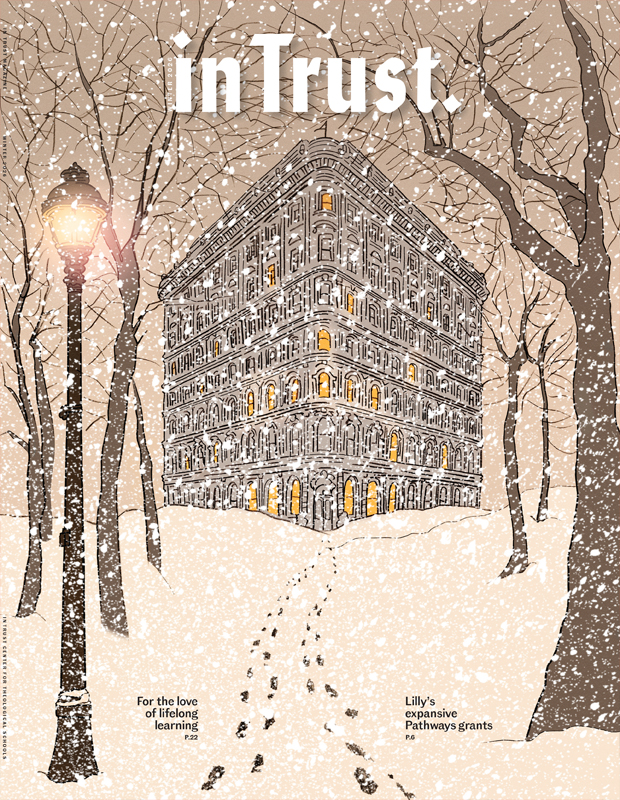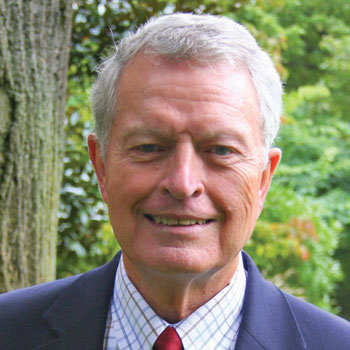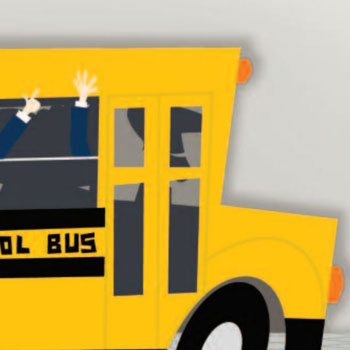 In today’s educational environment, most seminaries and theological schools have difficulty recruiting enough students to make full use of their faculty and facilities. But presidents who wring their hands over the struggle to maintain enrollment often add, “We still attract some amazing students who would succeed in any vocation, yet they choose ministry.”
In today’s educational environment, most seminaries and theological schools have difficulty recruiting enough students to make full use of their faculty and facilities. But presidents who wring their hands over the struggle to maintain enrollment often add, “We still attract some amazing students who would succeed in any vocation, yet they choose ministry.”
Who are these “amazing” students? What education and experiences nudge them toward religious leadership? How do outstanding students differ from average ones? And how might schools attract more excellent seminarians?
The Auburn Center for the Study of Theological Education, in collaboration with the Association of Theological Schools (ATS), assembled a research team that interviewed 261 graduate students cited as the “best” by 24 theological and rabbinical schools. The project required that the students be open to vocational ministry and that they be among those “the school is very happy to have.” The team also analyzed data from surveys — both earlier Auburn studies and questionnaires administered by ATS to entering and graduating seminary students — to determine whether gifted students came from backgrounds very different from the general student population.
The goal of the study was to identify factors that led students to theological schools. Its major finding: The pathway to seminary is the long, slow nurture of faith in community.
Therefore, schools cannot, by clever marketing, rake in applicants who never before thought about ministry. Rather, students who find their way to seminary have been on the path for a long time.
The “best” — and most of the rest — have been embedded in religious culture, involved in religious institutions, and exposed to religious role models over time. Their development has been a shared responsibility of many partners for many years.
Shaping tomorrow’s spiritual leaders
Detailed findings of the Auburn project will be available by November 2013 on the Center’s website, www.auburnseminary.org/pathways-to-seminary. In this article, we summarize the factors that influence very able students to attend seminary. We also include comments from gifted students who participated in the study.
Family stability. The best students came to seminary from strikingly stable families. In a society in which half of all children see their parents divorce, only 17 percent of the interviewed students had that experience. Significant numbers of parents modeled lives of service in their choice of occupation. One-third of mainline Protestant and Roman Catholic/Orthodox interviewees had fathers in ministry or another helping profession; half of interviewees in evangelical Protestant schools had fathers in this category, and one in five was the child of a minister.
Mothers of seminarians were even more committed to lives of service. Two-thirds of the mothers of students in Roman Catholic and Orthodox schools worked in helping professions such as nursing or teaching. Here a candidate for the Roman Catholic priesthood talks about his early influences: I think my parents’ example … the way that they raised us. … I realized that having watched the time that they put into maintaining their marriage but then also sharing that with others. They modeled … service as a lifestyle. [And then having a Jesuit] as my uncle — going back to when I was growing up, I had a poster of Oscar Romero on my door.
Religious nurturing. Almost all of the interviewed students and their parents attended church or were immersed in synagogue or religious life. Many said they were in church or religious activities “every time the door was open.” One sector was a partial exception to this pattern of early religious formation: Students in evangelical seminaries had both the highest percentage of parents deeply involved in religious life and the highest percentage of parents with no religious participation. One quarter of the evangelical students came from families with no church involvement, whereas none of the mainline Protestants, Roman Catholics, Christian Orthodox, or Jewish students did. Nevertheless, evangelical students from unchurched backgrounds found themselves on the path to a religious vocation at an early age. They were influenced by parachurch campus ministries (like Young Life or InterVarsity Christian Fellowship), which are effective at attracting and incorporating young people who are floating free religiously. By the end of the teenage years, there were no differences in level of religious involvement among the interviewees by religious group.
Patterns of embeddedness. Three patterns of religious embeddedness were evident in the early lives of interviewees. First, there were the “totally immersed” — most of the Christian Orthodox, the denominational evangelicals and some Roman Catholic and Jewish students. They came to seminary from a religious cul-de-sac, having spent their lives in a religious world held together and sealed off from the rest of society by ethnic ties or separatist principles. Students in this group grew up knowing almost no one outside their religious tradition.
A second pattern was the “organizationally hooked.” Most interviewees enrolled in mainline Protestant and Jewish institutions, and substantial numbers in Roman Catholic and evangelical schools, had one foot in religious life and the other outside of it. They and their families participated in congregations and church activities but attended public schools and took part in secular programs and organizations. What kept them latched to the faith were well-organized religious activities for young people — youth groups, camps, mission trips and service programs. All of these played a major role in keeping this half-and-half group on the path to religious commitment and seminary. Here’s one woman’s story:
I grew up going to church every Sunday. When I was young, my parents took me, and as I got to about sixth grade, they let me make the decision whether or not I wanted to go.
I kept choosing to go. A couple of times I dragged them to church. They didn’t want to get up and go, but I did. Our family continued to go to the First United Methodist Church. … We were there about 16 years. …
I was an active member of the youth group.
In college [which was United Methodist], I attended the United Methodist church in town and was on the Religious Life Council.
I attended chapel regularly throughout school and participated in small group activities. Church camp had a huge impact on me.
I have never felt the continued presence of God more than at that camp. It was interesting because I made connections to people I never realized were going to be so important [when I applied to seminary] throughout the Conference and then the Jurisdiction.
A third pattern of connection, best labeled “enculturation,” was evident in the histories of students who grew up in certain sectors of evangelicalism, including the black church. They weren’t necessarily tied to a specific denomination, but rather they were consistently exposed to a strong religious culture that shared theological ideas, language patterns, music, worship styles, books, and iconic leaders. Even though these students and their families floated from one congregation to another, often crossing denominational boundaries, that strong culture kept them linked to a tradition almost as tightly as if they had been part of an enclosed national group or a highly organized denomination.
Education. To different extents, school attendance became part of the process of enmeshing students in religious faith and practice. Most mainline Protestant and Jewish seminarians who were interviewed went to public high schools, but one quarter of evangelicals were home-schooled or attended a Christian school, and half of Roman Catholics graduated from a Catholic high school.
In college, the pattern was somewhat reversed: mainline Protestants, who were almost all public school graduates, were more likely than others to attend a private college, often one with church ties. All students — Catholic and Protestant — who went to Christian colleges were further knit into the fabric of religious life. A high percentage majored in theology or religion.
Three other factors played significant parts in leading able students to seminary.
Role models. Students who attend seminary saw ministry done well, at close range. Here, a student describes his encounter with a priest who was showing him a preseminary high school he might attend: The priest comes five minutes late because he couldn’t find the school. He comes running up the stairs, he’s sweating; he’s just exhausted. But one thing I picked up from that priest was he didn’t sell me on the gym … he didn’t sell me on the computers. … But he was joy-filled, happy, at peace, excited. … And at that time I couldn’t put a name on it, but I said whatever that priest has, I want it. Or if I don’t want that, I want to be in an atmosphere where people really care.
Peer groups. It was important for most interviewees to find friends who shared their views and values. Several said they tamped down their ministry aspirations as long as they were part of a circle that didn’t think religious faith was cool. They took their spiritual promptings seriously after they found peer support in a youth group, Bible study, campus ministry program or a gathering of religiously committed friends. A rabbinical student describes how she, like many others, met such a group at a religious camp:
There were these young counselors with long hair playing guitars, and we were allowed to call that praying. Camp was where I first realized that maybe leading prayer would be cool because I thought my counselors were cool. And I thought, if they can make me feel this way then, like, why wouldn’t I want to be like them and make someone else feel this way?
Dramatic experiences. Many interviewees said clarity about their vocation stemmed from an experience that turned their world upside down, raising questions of meaning and life’s priorities. Sometimes these experiences came unbidden, in the form of tragedies like the death of a sibling or parent.
High school teaching provided a period of severe testing for students for whom life and achievement had previously been easy. In a number of cases, the jolting moment came in another culture or country. Here is one such story:
At the end of my freshman year, I took a medical mission trip with my home church to [a Central American country]. They put me in charge of eye exams. They put a big box of donated ugly 1970s glasses in front of me. That was all the training I got. I looked out the window, and there was this huge line of people waiting to see me. I did what I remembered from getting eye exams. I put a line on the floor with tape and hung up the eye chart. I arranged the glasses by how much they hurt my eyes. I have 20/20 vision, so the ones that didn’t hurt I put on one side, and the ones that hurt a lot on the other. If people made a lot of mistakes on the chart, I gave them the strong ones — if just a few, the others. It was an imperfect system at best. But for these people, it was the first time many of them could see. One little boy couldn’t see anything on the chart. I gave him glasses and he could read all the letters. His mother was crying. It was like a Bible story happening, even if through ordinary means. At that moment, I committed my life to the church. I knew I wanted to make a difference.
Seminary choice
When these students who were on a long, slow trek to seminary got to the point of selecting a theological school, how did they choose? Initial criteria, according to respondents to Auburn and ATS surveys, were the reputation of the school, the quality of its faculty, and whether it was the right theological fit for them. Very consistently, students rated theological comfort and a high opinion of the school first and other factors — location, convenience of scheduling, and even finances — second. The interviewees reported the same factors as weighing heavily in school choice, though they noted that practical considerations were often tie-breakers between two schools. Students are prone to believe that the school they have chosen is the best fit for them, so it is possible that, in the case of both the “best” students and others, that location and finances were more influential than students report.
 One factor in seminary choice has risen in the rankings since a survey 10 years ago: admissions staff and procedures. Young students especially can be courted effectively. A well-planned recruitment and admissions program won’t expand the pool of potential students but may help a school siphon some from another school’s pond.
One factor in seminary choice has risen in the rankings since a survey 10 years ago: admissions staff and procedures. Young students especially can be courted effectively. A well-planned recruitment and admissions program won’t expand the pool of potential students but may help a school siphon some from another school’s pond.
Seminary experience
Many of the students interviewed were at the beginning of their theological studies, so the research yielded limited information about how vocational aspirations take shape during seminary. Still, two themes were evident.
First, students frequently reported that seminary is a period of intense spiritual, vocational and intellectual formation. This testimony runs contrary to the notion, held by many in the church, that theological study is a faith-wrecking experience.
Second, many students described the same vocational trajectory. A minority in all Protestant religious sectors began seminary with an expressed interest in pastoral ministry in congregations, for which the curriculum was primarily designed.
This changed dramatically over time. By the end of their programs, sizeable numbers of students gravitated toward congregational ministry. Exposure to pastoral role models in field assignments and the experience of doing ministry seem to have played a large part in the change. Vocational goals took shape based on what students saw and experienced first hand. (Roman Catholics, Episcopalians, Eastern Orthodox, and Jews generally began their theological studies with an orientation to pastoral ministry or the rabbinate, but, like the Protestants, some who were dubious about those roles also changed their views during their time in theological school.)
Reflecting on the research
Are all theological students as rooted, embedded, supported and seasoned as these interviewees who are proxies for schools’ “best” students? It is hard to say. In the past, schools have overlooked the importance of students’ early lives as they have tried to recruit more and better applicants. Researchers have made the same mistake. Neither Auburn nor ATS has asked on previous surveys about background or experiences before college. From the sparse information available, it appears that average students are not as deeply enmeshed in religious cultures and institutions as the most promising students. Still, they are different from the society around them, where religious immersion is no longer the norm for young people. They have experienced a long and slow nurturing of their faith and continual prodding to consider the option of ministry.
Are there implications of these findings for institutional policies and practices? There are, but most have a dimension of challenge. In the short term, schools can increase their competitive advantage. Many interviewees reported that a thoughtful and careful admissions process had an impact on their decision about which school to attend. Relationships played the largest part in steering students to seminary, and recruitment procedures that offer personal attention and regular contact with staff probably produce more applications and possibly a higher yield of students who decide to attend.
Almost every other measure to increase the numbers of good students requires long-term investment. For example, the better a school is perceived to be, the more likely it is to sustain enrollment. Taking steps to raise an institution’s public profile and increase the quality of its faculty requires time and involves considerable expense.
Early identification can be an effective strategy.
In recent years, seminaries, denominations and agencies, often with help from Lilly Endowment Inc., have created programs to engage teens and young adults in theological study and introduce them to ministry in various forms. These include youth theology institutes, vocational discernment programs for adolescents and college students, and mission opportunities, along with less formal mechanisms like camp counseling and student chaplaincies in colleges. The more a school is connected to programs that bring young people into its magnetic field, the more likely it is to have younger students and highly capable students of all ages.
In the future, such programs will be more important than ever. As explained in “Sobering Figures Point to Enrollment Decline” (In Trust, Spring 2013, pages 5–11, www.intrust.org/enrollment-research), the only groups in the seminary population that have been increasing are the groups that are increasing in the North American population: Hispanics, African Americans and Asians. Able students in these groups are heavily recruited, often from a young age, by businesses and other professions.
If theological schools want to maintain the quality of their student bodies in the years to come, early identification will be a necessity.
Finally, theological faculties have a critical role to play. Many of their students and most of the best ones have backgrounds very different from the life experiences of most members of the society in which they will serve. The large majority have rich religious backgrounds, mentors with strong values and high ideals, supportive friends in the faith, and, in many cases, some formative experience of religious and social difference. They will leave seminary to serve in places where organized religion has diminished influence and where social polarization is intense. Seminary curriculum, much of which is now oriented to preparing people to serve in existing religious systems, must be redesigned to equip students to serve in settings very different from the religious enclaves in which they grew up. That is a tall order, requiring the review and the revision of both classroom instruction and opportunities for learning from practice. But if religious traditions and institutions are to have a future in North America, they will need leaders motivated and prepared to renew and rebuild. The theological schools of North America have an essential role to play in the education of those leaders.
Barbara G. Wheeler directed the Pathways to Seminary Project, on which this article is based. The complete report will be available by November at www.auburnseminary.org/pathways-to-seminary. The research team included Sharon L. Miller and Anthony T. Ruger, who are staff members at the Auburn Center for the Study of Theological Education, which sponsored the study with support from Lilly Endowment Inc. Helen M. Blier and Melissa Wiginton were also members of the team.




























